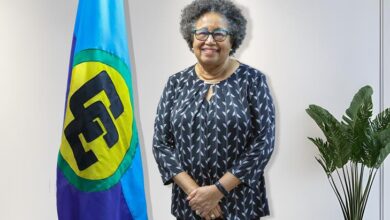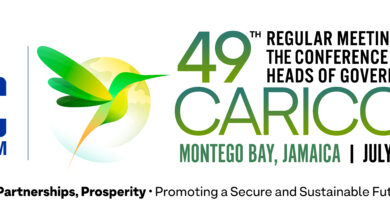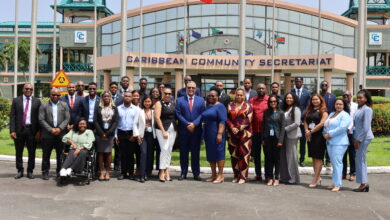Remarks by
Mr. Leo Titus Preville
Programme Manager, CARICOM Single Market, CSME Unit
at the Launch of the CARIFORUM-EU EPA and CSME Standby Facility for Capacity Building “Enhanced Technical Vocational Educational Training (TVET) Framework for Certification in Antigua and Barbuda”
Thursday, 07 April 2022, 10:00 A.M
Salutation
- Hon. E. P Chet Greene, Minister for Foreign Affairs, Immigration and Trade;
- Hon. Daryll Matthew, Minister for Education and Sports;
- Ambassador Malgorzata Wasilewska Head of Delegation European Union to Barbados and the Eastern Caribbean;
- Mr. Isaac Solomon, Vice President Operations Caribbean Development Bank;
- Ms. Barbara Williams, Deputy National Authorizing Officer – Ministry of Foreign Affairs, Immigration and Trade;
- Dr. Rev. Olson Daniel; Ms. Ileathea Cabral, Project Coordinator Office of the National Authorizing Officer – Ministry of Foreign Affairs, Immigration and Trade;
- other invited guests, distinguished ladies and gentlemen.
Presentation
It gives me great pleasure on behalf of the CARICOM Secretariat, CSME Unit, to deliver brief remarks on the launch of the first project for Antigua and Barbuda under the CARIFORUM-EU EPA and CSME Standby Facility for Capacity Building. This project, which seeks to strengthen the regulatory capacity of the Antigua and Barbuda National Training Agency, build both the human and physical capacity of the Antigua and Barbuda Institute for Continuing Education, destigmatize technical and vocational training, and importantly provide Antigua and Barbuda with the capacity for accreditation and certification of TVET programmes to the standard recognized under the Caribbean Vocational Qualification (CVQ) is very timely and important.
The decision by Member States of the Caribbean Community to establish a Single Market and Economy was meant to allow for the free movement of the factors of production, so that entrepreneurship and innovation could be encouraged, increase efficiencies in production of goods and services and hence greater competitiveness of the products produced, increase exports and growth of Member States’ economies and a better quality of life for the people of the region. The Revised Treaty also approached the movement of skilled nationals in a distinct manner as opposed to the general free movement of persons. Specific categories of skilled nationals are allowed to move in search of employment among Member States; however, there are qualifying criteria for the recognition of those skilled nationals. It is in this context that the programme of actions that will be undertaken in Antigua and Barbuda under this project is so important from the perspective of the Revised Treaty.
The capacity to provide certified TVET training means that nationals of Antigua and Barbuda who possess CVQs in the approved categories for free movement will be able to make their services available to the regional labour market. This has positive implications for the private sector in the region as a larger pool of skilled labour would be available. It also means that skilled labour will have a wider range of countries in which to provide their services and hence able to move to the countries where they are able to get better value for their skills.
The outcome of this project also means that, over time, one will begin to see a reduction in unemployment and underemployment as qualified skilled persons will be able to seek employment opportunities throughout the region and beyond. With the qualifications attained, skilled persons would be able to command a higher wage rate given them a greater return for the hours of work.
The project also has implications for the attraction of both regional and international investment flows. Knowledge that qualified skilled sets are available in Antigua and Barbuda is an additional factor that will be considered by investors in deciding on where to invest. The investment being made under this project is therefore not simply building capacity for the eventual individuals who will take advantage of the TVET training that will be offered, it goes well beyond this. It is about positioning Antigua and Barbuda as a place for investing and doing business. It is about positioning the Region as a place of excellence in human capacity and hence a growth pole.
For CARICOM Member States such as Antigua and Barbuda with limited natural resources and a heavy reliance on services, especially tourism, the quality of the human resources is central to its completeness. The ability to maintain and increase market share in a globally competitive tourism industry goes beyond the much-touted sea, sun, and sand. It is about being able to keep adding value to guests. This typically lies in the quality of the people who work in the industry. It is their capacity to deliver exceptional service, to keep innovating and to differentiate their product that will keep the tourism industry growing. This is all founded on a basis of having trained and qualified human resources.
The other Member States of the Community also stand to benefit from the output of a qualified workforce from a country such as Antigua. It is the increased disposable incomes from the trained persons working in the services sector that make it possible for those countries that focus more on the production of goods, to export to countries such as Antigua and Barbuda. It is in that manner that the free movement of goods regime stands to benefit from a project that builds human capacity in a services-oriented Member State.
The CARICOM Secretariat is therefore pleased that this project as been approved for the people of Antigua and Barbuda under the Standby Facility. The Secretariat commends the Government of Antigua and Barbuda for its foresight in the choice of project that was submitted for support under the Facility and therefore wishes for a successful implementation of all five components of the project over its two-year life span.
I thank You.






